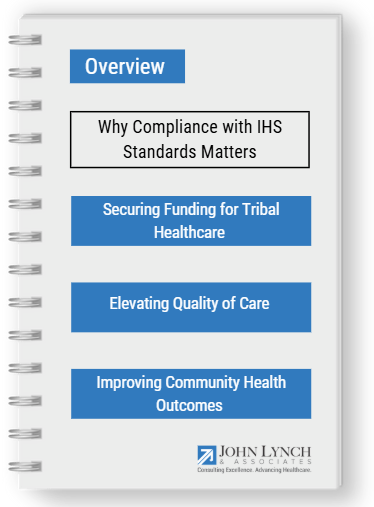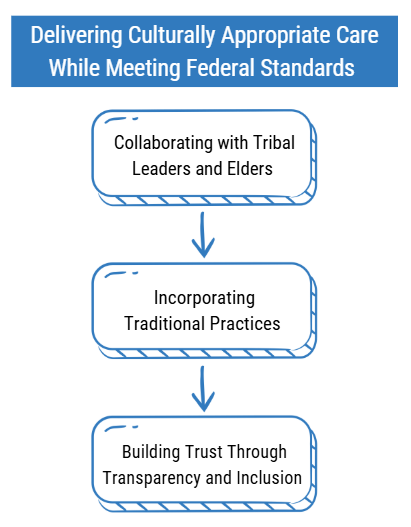
Mastering IHS Standards: Ensuring Compliance & Quality Care
February 5, 2025Indian Health Service (IHS) is vital to delivering healthcare across American Indian and Alaska Native communities, ensuring access to critical services and addressing health disparities.
For many Tribal health facilities, IHS funding represents a lifeline that supports both day-to-day operations and long-term health initiatives.
But access to this funding—and the ability to sustain high-quality care—depends heavily on meeting IHS compliance standards. These regulations are designed to protect patients and uphold care quality, yet navigating them can feel overwhelming, especially for smaller or resource-limited facilities.
Therefore, understanding the role of compliance is essential for Tribal health leaders seeking to secure financial resources, improve care, and enhance community health.
This guide will help you navigate Indian Health Service regulations confidently, ensuring that your facility not only meets these standards but thrives while respecting cultural values and traditions.
Why Compliance with IHS Standards Matters
For Tribal health facilities, compliance with IHS standards is more than just a regulatory requirement—it’s a cornerstone of sustainable, high-quality healthcare. By aligning with these guidelines, facilities unlock crucial funding, improve patient care, and build healthier communities.

Securing Funding for Tribal Healthcare
Access to IHS funding directly depends on compliance. Grants, contracts, and operational budgets are contingent upon meeting the necessary standards, allowing facilities to expand services and invest in their infrastructure.
However, even minor compliance issues can jeopardize this financial support, putting essential healthcare programs at risk. For many Tribal facilities, the potential loss of funding could mean scaling back services or delaying critical improvements.
By prioritizing compliance, health leaders not only protect their existing funding but also position their facilities for future growth. This creates a more stable, resilient healthcare environment that can better serve the needs of the community.
Elevating Quality of Care
Compliance isn’t just about funding—it directly influences the quality of care delivered. Adhering to federal healthcare standards for tribes ensures that patient services are safe, effective, and consistently meet the highest benchmarks.
When facilities fall behind on compliance, gaps in care protocols or outdated practices can compromise patient safety and outcomes. These lapses can erode trust and leave communities underserved.
On the other hand, a commitment to compliance drives continuous improvement, empowering providers to deliver more reliable and culturally responsive care. This ultimately strengthens the relationship between healthcare providers and the communities they serve.
Improving Community Health Outcomes
Compliance plays a pivotal role in shaping long-term health outcomes. Facilities that consistently meet IHS standards are better equipped to offer preventive care, manage chronic conditions, and address public health challenges.
Yet, without adherence to these guidelines, disparities can widen, and health initiatives may struggle to gain traction. Missed opportunities for screenings, underfunded wellness programs, and fragmented services contribute to ongoing health inequities.
By embedding compliance into the foundation of care, Tribal health facilities invest in the future well-being of their communities. This focus not only mitigates immediate risks but fosters a healthier, more vibrant population over time.
Common Challenges in Meeting IHS Standards
Achieving and maintaining IHS compliance is critical, but the path to compliance is often marked by significant challenges. For many Tribal health facilities, balancing the complexity of federal regulations with the unique needs and values of their communities can feel like navigating uncharted waters. By recognizing and addressing these hurdles, facilities can take proactive steps toward sustainable compliance and long-term success.
Navigating Indian Health Service Regulations
IHS guidelines are designed to ensure consistent, high-quality healthcare, covering everything from facility operations to patient care protocols.
But the regulations are complex and frequently updated, requiring facilities to stay vigilant and adaptable. For Tribal health leaders already managing day-to-day responsibilities, keeping pace with evolving IHS policy guidelines can be a daunting task.
Therefore, developing systems to track regulatory changes and investing in staff training is essential. By creating internal teams or partnering with compliance experts, facilities can stay ahead of policy shifts and avoid potential pitfalls. Proactive engagement with IHS resources and attending regular workshops or webinars can also help demystify complex regulations.
Balancing Compliance and Cultural Appropriateness
Federal healthcare standards are necessary to ensure quality and safety, but they don’t always align seamlessly with Tribal customs and traditions.
While IHS standards aim to enhance care delivery, certain protocols may inadvertently overlook or conflict with cultural practices that are vital to community well-being. This disconnect can lead to hesitation or resistance in fully implementing certain aspects of compliance.
By collaborating closely with Tribal leaders and elders, healthcare administrators can find solutions that respect cultural values without compromising federal standards. Incorporating traditional healing practices, culturally relevant wellness programs, and inclusive care models can create a more harmonious balance between compliance and community-driven healthcare.
Limited Resources for Compliance Audits
Regular compliance audits are essential for identifying gaps and ensuring that facilities consistently meet IHS standards. However, smaller or more remote Tribal health facilities often operate with limited resources, making it difficult to conduct thorough reviews or implement corrective actions.
In these cases, compliance may take a backseat to more immediate operational demands, increasing the risk of falling out of alignment with Indian Health Service regulations.
To address this, facilities can explore partnerships with external organizations that specialize in compliance audits for Tribal health services. Leveraging outside expertise not only lightens the internal workload but also ensures that audits are conducted with precision and objectivity. Additionally, prioritizing key compliance areas and focusing on the highest-risk issues first can help maximize impact, even with constrained resources.

Practical Steps to Ensure Compliance
While the challenges of achieving IHS compliance are significant, they are not insurmountable. By adopting a proactive approach and implementing structured processes, Tribal health facilities can streamline compliance efforts, protect funding, and enhance care delivery. These practical steps provide a roadmap to success, ensuring that facilities remain aligned with Indian Health Service regulations while honoring community values.
Conducting Regular Compliance Audits
Routine compliance audits are one of the most effective ways to identify gaps and ensure continuous improvement. Regular reviews provide insight into operational strengths and highlight areas that need corrective action.
However, audits can be time-intensive and require careful preparation to be effective. Without clear planning, critical issues may go unnoticed, leading to compliance vulnerabilities.
Establishing a consistent audit schedule and designating internal compliance officers or teams ensures that the process remains organized and thorough. For facilities with limited capacity, partnering with external consultants experienced in compliance audits for Tribal health services can provide valuable oversight and actionable recommendations.
Understanding IHS Policy Guidelines
Staying informed about evolving IHS policy guidelines is essential for maintaining compliance. Regulatory updates may introduce new standards or modify existing ones, directly impacting operations and funding eligibility.
However, without ongoing education, even experienced staff may find it challenging to keep up with the nuances of federal healthcare standards for tribes. This can lead to unintentional oversights and compliance risks.
Investing in staff training and professional development ensures that team members are equipped to interpret and implement policy changes effectively. Encouraging participation in IHS webinars, workshops, and online resources fosters a culture of compliance and empowers teams to take ownership of regulatory requirements.
Partnering with Experts in Tribal Healthcare Compliance
Navigating the complexities of IHS compliance can be overwhelming, especially for smaller facilities or those new to certain regulatory frameworks. Seeking external expertise provides a strategic advantage, ensuring that compliance efforts are thorough, efficient, and tailored to the unique needs of Tribal communities.
Despite the benefits, some facilities hesitate to engage outside partners, often due to budget constraints or a desire to manage compliance internally. Yet, the cost of non-compliance—in terms of funding loss, care disruptions, and reputational damage—can far exceed the investment in external support.
By collaborating with experienced firms, Tribal health leaders can access customized compliance solutions for Tribal health facilities that address facility-specific challenges. External experts can assist with policy interpretation, audits, staff training, and long-term compliance planning, allowing facilities to focus on delivering exceptional care to their communities.
Proven Results with John Lynch & Associates
When a Tribal health client faced mounting concerns around healthcare compliance, they turned to John Lynch & Associates for support. We developed a culturally aligned compliance roadmap that respected their unique governance structure, addressing gaps in privacy practices, billing procedures, and quality reporting. Our comprehensive approach included policy development, staff training, internal audits, and reporting systems, ensuring both tribal and federal standards were met. The results speak for themselves: increased staff confidence, a significant reduction in compliance violations, and a safer, more secure healthcare environment for the community.
Delivering Culturally Appropriate Care While Meeting Federal Standards
For Tribal health facilities, compliance with IHS standards is not just about adhering to federal regulations—it’s about delivering care that reflects the values, traditions, and beliefs of the community. While federal healthcare standards for tribes are designed to ensure safety and quality, they must be implemented in a way that respects and preserves Tribal identity and cultural integrity.

Collaborating with Tribal Leaders and Elders
Effective compliance begins with listening to the community. Tribal leaders and elders hold invaluable knowledge about the cultural practices and health priorities that shape the lives of their people. By involving them in the development of care protocols and policies, health facilities can ensure that compliance measures feel aligned rather than imposed.
Without this collaboration, policies can inadvertently overlook cultural nuances, resulting in care models that lack community trust or engagement. This disconnect can undermine the very health initiatives intended to benefit the population.
Building advisory boards or regular consultation groups with elders and leaders fosters mutual respect and creates a framework where compliance efforts are shaped by shared wisdom and lived experience. In doing so, facilities not only strengthen regulatory alignment but deepen community relationships and foster long-term health improvement.
Incorporating Traditional Practices
Blending traditional healing practices with modern healthcare services is a cornerstone of culturally appropriate care. Many Tribal communities rely on ceremonies, natural medicine, and holistic approaches that have been passed down for generations.
However, integrating these practices can sometimes present challenges within the framework of federal healthcare standards. Facilities may feel pressure to prioritize clinical models at the expense of cultural traditions.
By establishing culturally inclusive care pathways, facilities can ensure that traditional practices are respected and even enhanced through collaboration with medical professionals. This dual approach not only meets compliance requirements but also reflects the unique strengths of Tribal healing systems, reinforcing the community’s connection to its roots while receiving modern medical support.
Building Trust Through Transparency and Inclusion
Trust is foundational to compliance and care quality. When patients feel that healthcare services are designed with their cultural identity in mind, they are more likely to engage with preventive care, follow treatment plans, and participate in health programs.
On the other hand, a lack of transparency or visible community involvement can foster skepticism and disengagement. This, in turn, can create barriers to achieving full compliance with IHS regulations.
Creating open lines of communication between facility leadership and the community fosters greater trust. Hosting listening sessions, surveys, and community health events ensures that patient voices are heard and reflected in care delivery. By demonstrating a commitment to inclusion, facilities enhance both patient satisfaction and regulatory success.
The Path to Compliance Success
Achieving and maintaining compliance with IHS standards is not just a regulatory necessity—it’s a pathway to stronger, healthier Tribal communities. When Tribal health facilities align with Indian Health Service regulations, they unlock the potential for sustained funding, improved care delivery, and enhanced community well-being.
However, compliance is more than meeting checklists and passing audits. It requires a continuous commitment to balancing federal requirements with cultural values and addressing the unique health challenges faced by Tribal populations.
By embedding compliance into the foundation of healthcare operations, Tribal health leaders can ensure their facilities are not only meeting standards but thriving. This proactive approach paves the way for greater stability, trust, and empowerment across communities.
Success lies in collaboration. When health facilities engage with Tribal leaders, elders, healthcare professionals, and external experts, they build stronger systems capable of adapting to regulatory changes without losing sight of cultural heritage.
For facilities seeking support in navigating IHS policy guidelines or conducting compliance audits for Tribal health services, partnerships with trusted advisors can make all the difference. Firms like John Lynch & Associates offer specialized knowledge and hands-on experience in helping Tribal facilities meet and exceed compliance goals while fostering community-driven care.
Is your Tribal health facility ready to strengthen its path to IHS compliance?
Contact us today to schedule a free consultation and discover how John Lynch & Associates can guide your organization to compliance success—while honoring the values and traditions that make your community unique.
